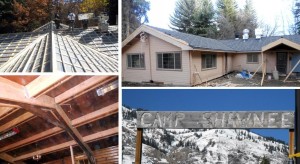
For the roof rebuild at Camp Shawnee’s main lodge in Liberty, Utah, we chose a design that combined new materials with the rustic look of the existing building.
It’s become a cliché: “Winter is coming.” But for many areas of the US, winter is already here. And in mountainous areas like Utah, that means a lot of snow. And a lot of snow means extra loads on roofs.
While McNeil Engineering provides engineering services across the country, many of our clients are located close to our home office in the greater Salt Lake City area. That means we have a great deal of experience providing the civil, structural and roofing engineering design that this particular climate demands.
Let’s take a closer look at how to prepare roofs of houses and buildings for the particular stresses and demands of Utah year-round, and especially through the winter.
Load bearing
The roof snow load is an engineering measurement that shows how much precipitation a roof can hold before it faces the risk of collapsing. That number or load depends on a number of factors, including the shape of the roof, the materials it’s built of, and the climate in your area.
In Salt Lake County, local building codes state that the roof snow load is 30 pounds per square foot. In other words, the roof frame must be designed and constructed to withstand a minimum of 30 pounds of load on top of it for every square foot of roof surface area.
How much snow does that mean? That can depend on the nature of the snow. As anyone who’s ever shoveled a driveway knows, the weight of snow per shovelful, or its density, can vary widely. Warmer, wet snow can be several times the weight of dryer, colder snow.
The Federal Emergency Management Agency (FEMA) guidelines have a wide range of snow density, from 3 to 21 pounds per square foot of roof.
Freezing rain can build up to as much as 57 pounds per square foot, making it a much greater concern for roof stress than snow.
Start with design
Most people think that a steep, gable-style roof is best for buildings in areas that get a lot of snow. A roof with a steep pitch, or angle, is able to shed water, ice and snow more easily than a flat roof or one with a shallower pitch. However, steeper slope or greater pitch allows large amounts of snow and ice to fall at once, which can be dangerous for objects and people below.
The pitch is not the only factor to consider. Complex roof designs, with more than one gable or slope, can trap large amounts of snow in the valleys between the different parts of the roof.
A flat roof is not necessarily ruled out by the location in a snowy area. Framing, materials and construction techniques also play important roles in the load-bearing capacity of a roof.
Besides rain, snow and ice, architects and civil engineers must also take into account other stresses or loads on the building: wind sheer and earthquake resistance, for example. So it is possible to design a building with a flat roof that can withstand the heaviest snow loads in your area.
Remember, too, that a high gable or pitch adds to the wind stress on a building. A severe windstorm can cause more damage to a high gable than to a flat roof.
Architects and engineers take the prevailing wind direction and climatic conditions, as well as orientation of the building and site, into account when designing roofs.
Other than a slope, there are other features the design can use to shed excess water, including gutters and downspouts.
Snow is not just a load, either — it’s insulating. Every inch of snow on a flat roof adds one R-factor of insulation, which means a foot of snow on top of a flat roof adds an R-12 to the building.
Maintenance
The best designed and constructed roof has to be maintained to endure the changes of weather through the year. As the cold weather approaches, take some preventive steps to ensure your roof continues to protect you.
- Check for leaks. Cold weather will make them expand, leading to more water coming in. Call in a professional for a thorough inspection. You can also do an inspection inside. Any dark or damp spots on the ceiling or tops of the walls can be signs of a leaking roof.
- Clean gutters and downspouts. This will ensure water can flow freely off your roof and away from your building. Downspouts clogged with leaves and debris can lead to ice jams, which can cause leaks into the building.
- Replace broken or cracked shingles and flashing. These can lead to leaks and many other problems. Use a professional to ensure the job is done right.
- Ensure water drains at least 4 feet from the foundation. Otherwise, ice can build up against the foundation, leading to leaks that can be difficult to fix.
Call in the professionals
If you’re concerned about the roof of any of your buildings, from a home to a commercial building, contact our roofing consulting professionals. Let’s talk about what you need.








